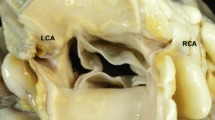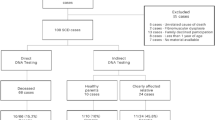Abstract
Forensic medicine defines the unexplained sudden death as a death with a non-conclusive diagnosis after autopsy. Molecular diagnosis is being progressively incorporated in forensics, mainly due to improvement in genetics. New genetic technologies may help to identify the genetic cause of death, despite clinical interpretation of genetic data remains the current challenge. The identification of an inheritable defect responsible for arrhythmogenic syndromes could help to adopt preventive measures in family members, many of them asymptomatic but at risk of sudden death. This multidisciplinary translational research requires a specialized team.


Similar content being viewed by others
References
Basso C, Burke M, Fornes P, Gallagher PJ, de Gouveia RH, Sheppard M, Thiene G, van der Wal A (2008) Guidelines for autopsy investigation of sudden cardiac death. Virchows Arch 452(1):11–18
Lawler W (1990) The negative coroner’s necropsy: a personal approach and consideration of difficulties. J Clin Pathol 43(12):977–980
Oliva A, Brugada R (2010) D’Aloja E, Boschi I, Partemi S, Brugada J. State of the art in forensic investigation of sudden cardiac death. Am J Forensic Med Pathol, Pascali VL
Ackerman MJ, Priori SG, Willems S, Berul C, Brugada R, Calkins H, Camm AJ, Ellinor PT, Gollob M, Hamilton R et al (2011) HRS/EHRA expert consensus statement on the state of genetic testing for the channelopathies and cardiomyopathies this document was developed as a partnership between the Heart Rhythm Society (HRS) and the European Heart Rhythm Association (EHRA). Heart Rhythm 8(8):1308–1339
Tfelt-Hansen J, Winkel BG, Grunnet M, Jespersen T (2011) Cardiac channelopathies and sudden infant death syndrome. Cardiology 119(1):21–33
Devinsky O (2011) Sudden, unexpected death in epilepsy. N Engl J Med 365(19):1801–1811
Michaud K, Mangin P, Elger BS (2011) Genetic analysis of sudden cardiac death victims: a survey of current forensic autopsy practices. Int J Legal Med 125(3):359–366
Pachon M, Almendral J (2011) Sudden death: managing the patient who survives. Heart 97(19):1619–1625
Adabag AS, Luepker RV, Roger VL, Gersh BJ (2010) Sudden cardiac death: epidemiology and risk factors. Nat Rev Cardiol 7(4):216–225
Arzamendi D, Benito B, Tizon-Marcos H, Flores J, Tanguay JF, Ly H, Doucet S, Leduc L, Leung TK, Campuzano O et al (2011) Increase in sudden death from coronary artery disease in young adults. Am Heart J 161(3):574–580
Pilmer CM, Kirsh JA, Hildebrandt D, Krahn AD, Gow RM: Sudden cardiac death in children and adolescents between 1 and 19 years of age. Heart Rhythm 2013
Tester DJ, Ackerman MJ (2012) The molecular autopsy: should the evaluation continue after the funeral? Pediatr Cardiol 33(3):461–470
Basso C, Carturan E, Pilichou K, Rizzo S, Corrado D, Thiene G (2010) Sudden cardiac death with normal heart: molecular autopsy. Cardiovasc Pathol 19(6):321–325
Carturan E, Tester DJ, Brost BC, Basso C, Thiene G, Ackerman MJ (2008) Postmortem genetic testing for conventional autopsy-negative sudden unexplained death: an evaluation of different DNA extraction protocols and the feasibility of mutational analysis from archival paraffin-embedded heart tissue. Am J Clin Pathol 129(3):391–397
Partemi S, Berne PM, Batlle M, Berruezo A, Mont L, Riuro H, Ortiz JT, Roig E, Pascali VL, Brugada R et al: Analysis of mRNA from human heart tissue and putative applications in forensic molecular pathology. Forensic Sci Int 2010
Elger BS, Michaud K, Fellmann F, Mangin P (2010) Sudden death: ethical and legal problems of post-mortem forensic genetic testing for hereditary cardiac diseases. Clin Genet 77(3):287–292
Roberts JD, Gollob MH (2010) The genetic and clinical features of cardiac channelopathies. Futur Cardiol 6(4):491–506
Jacoby D, McKenna WJ (2012) Genetics of inherited cardiomyopathy. Eur Heart J 33(3):296–304
Giudicessi JR, Ackerman MJ (2013) Determinants of incomplete penetrance and variable expressivity in heritable cardiac arrhythmia syndromes. Translational research. J Lab Clin Med 161(1):1–14
Hendrix A, Borleffs CJ, Vink A, Doevendans PA, Wilde AA, van Langen IM, van der Smagt JJ, Bots ML, Mosterd A (2012) Cardiogenetic screening of first-degree relatives after sudden cardiac death in the young: a population-based approach. Europace 13(5):716–722
Klaver EC, Versluijs GM, Wilders R (2011) Cardiac ion channel mutations in the sudden infant death syndrome. Int J Cardiol 152(2):162–170
Brion M, Quintela I, Sobrino B, Torres M, Allegue C, Carracedo A: New technologies in the genetic approach to sudden cardiac death in the young. Forensic Sci Int 2010
Behr E, Wood DA, Wright M, Syrris P, Sheppard MN, Casey A, Davies MJ, McKenna W (2003) Cardiological assessment of first-degree relatives in sudden arrhythmic death syndrome. Lancet 362(9394):1457–1459
Ormondroyd E, Moynihan C, Watson M, Foster C, Davolls S, Ardern-Jones A, Eeles R (2007) Disclosure of genetics research results after the death of the patient participant: a qualitative study of the impact on relatives. J Genet Couns 16(4):527–538
Abriel H, Zaklyazminskaya EV (2013) Cardiac channelopathies: genetic and molecular mechanisms. Gene 517(1):1–11
Napolitano C, Bloise R, Monteforte N, Priori SG (2012) Sudden cardiac death and genetic ion channelopathies: long QT, Brugada, short QT, catecholaminergic polymorphic ventricular tachycardia, and idiopathic ventricular fibrillation. Circulation 125(16):2027–2034
Campuzano O, Beltran-Alvarez P, Iglesias A, Scornik F, Perez G, Brugada R (2010) Genetics and cardiac channelopathies. Genet Med 12(5):260–267
Brugada P, Brugada J (1992) Right bundle branch block, persistent ST segment elevation and sudden cardiac death: a distinct clinical and electrocardiographic syndrome. A multicenter report. J Am Coll Cardiol 20(6):1391–1396
Berne P, Brugada J (2012) Brugada syndrome 2012. Circ J 76(7):1563–1571
Vatta M, Dumaine R, Varghese G, Richard TA, Shimizu W, Aihara N, Nademanee K, Brugada R, Brugada J, Veerakul G et al (2002) Genetic and biophysical basis of sudden unexplained nocturnal death syndrome (SUNDS), a disease allelic to Brugada syndrome. Hum Mol Genet 11(3):337–345
Campuzano O, Allegue C, Brugada R: [Genetics of sudden unexplained death.]. Medicina clinica 2013
Riuro H, Beltran-Alvarez P, Tarradas A, Selga E, Campuzano O, Verges M, Pagans S, Iglesias A, Brugada J, Brugada P et al (2013) A missense mutation in the sodium channel beta2 subunit reveals SCN2B as a new candidate gene for Brugada syndrome. Hum Mutat 34(7):961–966
Kapplinger JD, Tester DJ, Alders M, Benito B, Berthet M, Brugada J, Brugada P, Fressart V, Guerchicoff A, Harris-Kerr C et al (2010) An international compendium of mutations in the SCN5A-encoded cardiac sodium channel in patients referred for Brugada syndrome genetic testing. Heart Rhythm 7(1):33–46
Roden DM (2008) Clinical practice. Long-QT syndrome. N Engl J Med 358(2):169–176
Schwartz PJ, Crotti L, Insolia R (2012) Long-QT syndrome: from genetics to management. Circ Arrhythm Electrophysiol 5(4):868–877
Wilders R (2012) Cardiac ion channelopathies and the sudden infant death syndrome. ISRN Cardiol 2012:846171
Tester DJ, Benton AJ, Train L, Deal B, Baudhuin LM, Ackerman MJ (2010) Prevalence and spectrum of large deletions or duplications in the major long QT syndrome-susceptibility genes and implications for long QT syndrome genetic testing. Am J Cardiol 106(8):1124–1128
Winkel BG, Larsen MK, Berge KE, Leren TP, Nissen PH, Olesen MS, Hollegaard MV, Jespersen T, Yuan L, Nielsen N et al (2012) The prevalence of mutations in KCNQ1, KCNH2, and SCN5A in an unselected national cohort of young sudden unexplained death cases. J Cardiovasc Electrophysiol 23(10):1092–1098
Gussak I, Brugada P, Brugada J, Wright RS, Kopecky SL, Chaitman BR, Bjerregaard P (2000) Idiopathic short QT interval: a new clinical syndrome? Cardiology 94(2):99–102
Patel U, Pavri BB (2009) Short QT syndrome: a review. Cardiol Rev 17(6):300–303
Antzelevitch C, Pollevick GD, Cordeiro JM, Casis O, Sanguinetti MC, Aizawa Y, Guerchicoff A, Pfeiffer R, Oliva A, Wollnik B et al (2007) Loss-of-function mutations in the cardiac calcium channel underlie a new clinical entity characterized by ST-segment elevation, short QT intervals, and sudden cardiac death. Circulation 115(4):442–449
Templin C, Ghadri JR, Rougier JS, Baumer A, Kaplan V, Albesa M, Sticht H, Rauch A, Puleo C, Hu D et al (2011) Identification of a novel loss-of-function calcium channel gene mutation in short QT syndrome (SQTS6). Eur Heart J 32(9):1077–1088
Ylanen K, Poutanen T, Hiippala A, Swan H, Korppi M (2010) Catecholaminergic polymorphic ventricular tachycardia. Eur J Pediatr 169(5):535–542
Lahat H, Eldar M, Levy-Nissenbaum E, Bahan T, Friedman E, Khoury A, Lorber A, Kastner DL, Goldman B, Pras E (2001) Autosomal recessive catecholamine- or exercise-induced polymorphic ventricular tachycardia: clinical features and assignment of the disease gene to chromosome 1p13-21. Circulation 103(23):2822–2827
Barajas-Martinez H, Hu D, Ontiveros G, Caceres G, Desai M, Burashnikov E, Scaglione J, Antzelevitch C (2011) Biophysical and molecular characterization of a novel de novo KCNJ2 mutation associated with Andersen-Tawil syndrome and catecholaminergic polymorphic ventricular tachycardia mimicry. Circ Cardiovasc Genet 4(1):51–57
Roux-Buisson N, Cacheux M, Fourest-Lieuvin A, Fauconnier J, Brocard J, Denjoy I, Durand P, Guicheney P, Kyndt F, Leenhardt A et al: Absence of triadin, a protein of the calcium release complex, is responsible for cardiac arrhythmia with sudden death in human. Hum Mol Genet 2012
Nyegaard M, Overgaard MT, Sondergaard MT, Vranas M, Behr ER, Hildebrandt LL, Lund J, Hedley PL, Camm AJ, Wettrell G et al (2012) Mutations in calmodulin cause ventricular tachycardia and sudden cardiac death. Am J Hum Genet 91(4):703–712
Raffan E, Semple RK (2011) Next generation sequencing—implications for clinical practice. Br Med Bull 99:53–71
Tester DJ, Medeiros-Domingo A, Will ML, Haglund CM, Ackerman MJ (2012) Cardiac channel molecular autopsy: insights from 173 consecutive cases of autopsy-negative sudden unexplained death referred for postmortem genetic testing. Mayo Clin Proc Mayo Clin 87(6):524–539
Kauferstein S, Kiehne N, Jenewein T, Biel S, Kopp M, Konig R, Erkapic D, Rothschild M, Neumann T (2013) Genetic analysis of sudden unexplained death: a multidisciplinary approach. Forensic Sci Int 229(1–3):122–127
Acknowledgments
This work was supported by the “La Caixa” Foundation.
Conflict of interest
The authors have no conflicts of interest to declare.
Author information
Authors and Affiliations
Corresponding author
Rights and permissions
About this article
Cite this article
Campuzano, O., Allegue, C., Partemi, S. et al. Negative autopsy and sudden cardiac death. Int J Legal Med 128, 599–606 (2014). https://doi.org/10.1007/s00414-014-0966-4
Received:
Accepted:
Published:
Issue Date:
DOI: https://doi.org/10.1007/s00414-014-0966-4




